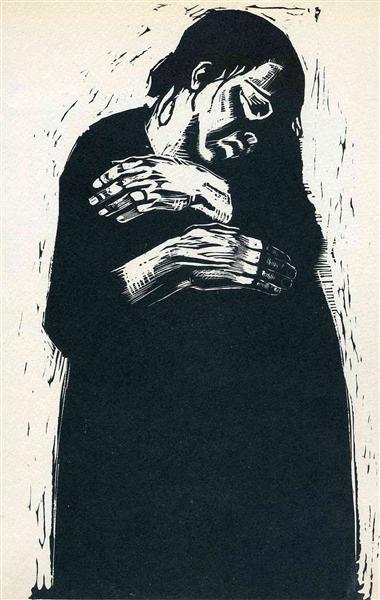Description
The work "The Widow I" by Käthe Kollwitz, painted in 1921, is a moving and deeply emotional testimony of human pain, a recurring theme in the production of this outstanding German artist. Kollwitz, recognized for his focus on social exploitation, war and feminine condition, uses his mastery in artistic expression to explore the anguish and loss that accompanies the experience of being a widow, an issue that deeply resonated in the context of Europe After World War I.
In this work, the central figure is a woman who embodies sadness and suffering. His face, captured with energetic and at the same time delicate strokes, reflects a deep sense of desolation. The sunken eyes and the expression of his face seem to tell a loss story, a way in which Kollwitz enters the psychology of his characters, delivering a palpable empathy towards his suffering. The little light that seems to illuminate its figure intensifies this gloomy atmosphere, immersing the viewer in a state of introspection before their pain.
The composition of "the widow I" is remarkable for its simplicity and its powerful visual impact. The figure of the woman is in the center, which invites the viewer's gaze to head towards her face and participate in her anguish. Kollwitz opts for a minimalist approach in color use; The dark and terrible tones predominate, which evoke a feeling of gravity and melancholy. This austere palette contributes to the oppressive atmosphere of the work and accentuates the emotional tumult of the protagonist.
The posture of the woman, hunched over and with tight arms around her body, suggests a containment of pain, which is both physical and emotional. Kollwitz often paints his characters in postures that transmit their internal struggle, and here this is evident. The figure seems to fight not only with the loss of their partner, but with a social system that frequently strips women of their rights and their dignity. This political dimension is a constant in Kollwitz's work, who has been a reference of art committed to social reality.
Käthe Kollwitz, in addition to her contribution as a painter, left a significant legacy as a recorder and sculptor. His style is characterized by an expressionist approach that highlights human emotion in its crudest form. "The widow I", although it is a painting, reflects its graphic style that characterizes it; The interaction between lines and forms captures the essence of suffering in a visceral way.
In the context of the art of the early twentieth century, Kollwitz's work stands out among a sea of avant -garde movements. His interest in human suffering and his explorations of femininity and war are deeply relevant in their time and continue to echo contemporaneity. Kollwitz's works, including "the widow I", have been interpreted as a call to compassion in times of despair, bringing the viewer closer to reflecting on the human condition and injustice.
In conclusion, "the widow I" of Käthe Kollwitz is not only a visual representation of pain, but a mirror of vulnerability and female resistance in a world that has often been hostile. His work, impregnated with a deep sense of empathy and a critical look at society, continues to resonate in a powerful way, consolidating Kollwitz as one of the most influential figures in the art of the twentieth century. The emotional power of his work invites contemplation and recognition of human suffering, aspects that become universal and timeless in their formidability.
KUADROS ©, a famous paint on your wall.
Hand-made oil painting reproductions, with the quality of professional artists and the distinctive seal of KUADROS ©.
Art reproduction service with satisfaction guarantee. If you are not completely satisfied with the replica of your painting, we refund your money 100%.

